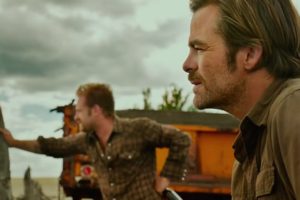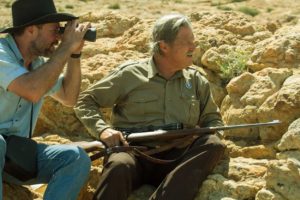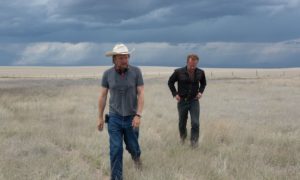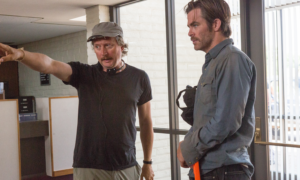
When British director David Mackenzie read Taylor Sheridan’s original Southwestern crime-based screenplay for Hell or High Water, he immediately connected with the material. “The script was so excellent, I said, ‘I don’t want to change a word,’” recalled Mackenzie.
In fact, the director and his team did change quite a bit in the end, but the film did not go through any studio development process. “It’s really fantastic to have good material that you just go, ‘I have a strong instinct this is really good,’” Mackenzie reflected. “What is interesting about it is it’s, at one level, a crime story, at another level, a road movie, a buddy movie, two brothers – there are all sort of flavors in there that are ripe for the plucking, and that’s what we tried to do. There are some opportunities for some really nice humor too.”
Indeed, starring Jeff Bridges as a retiring lawman on the trail of two brothers — played by Chris Pine and Ben Foster — on a robbing spree of banks in West Texas, Hell or High Water was partially improvised, releasing the comedic elements from the story. “There is a lot humor on the page, but I never read the humor because of its strong impression,” said Mackenzie, “but as soon as you put that dialogue into people’s hands, there’s humor there. It’s weird for me as a director; out of all of the films I’ve done, all have got some dark humor in them. They are all dramas, but, somehow, that says something about my sensibilities and something about my editor Jake Roberts’ sensibilities: we veer towards the humor.”

Even though he is British and said that he “tried not to be an outsider,” Hell or High Water is a uniquely American story, what the director calls “a snapshot of contemporary America;” as such, he took his British cinematographer, Giles Nuttgens, and Los Angeles-based production designer, Tom Duffield, on a scout of West Texas to find spots which echoed the descriptions in Sheridan’s script. “We shot a lot of photographs, and then we tried to replicate that in our choices of locations in New Mexico,” Mackenzie related. “I would loved to have shot it in West Texas in the real places that were described, but the financial incentives to shoot in New Mexico basically gave us another week’s filming. We needed that schedule time, so it was a decision that had to get made. It’s all location shooting, there’s no builds—the only thing we built was the mother’s bedroom on the end of the [main] ranch because the ranch was too small.”
With Duffield’s main tasks including modifications of practical locations, Mackenzie could achieve the realism he felt the screenplay mandated. “I much prefer things to be as real as they possibly can be when you start, so you already have a head start in terms of understanding what it is you are trying to represent,” he said. “We were able to find a lot of places very close to the Texan border in Clovis, New Mexico. We did our best to represent Texas as well as possible.”
According to Mackenzie, New Mexico offered him unique methods of framing his shots, giving the location the effect of being a character in the story. “I was really struck by the emptiness,” he stated. “Giles and I were very struck by the uncluttered frames that were around us. You usually try to find the frame in between busyness, but there’s so little there. When we selected that location for [the brothers’] ranch, for 360 degrees, is just flat eternity.”
One of the other things that New Mexico thematically provided was what Mackenzie labeled “guys on porches.” “There’s a thing about what a porch does on a hot day is a kind of refuge,” the director noted. “Particularly when you’ve got a long horizon, you scan the horizon for potential threats. There’s a respite — that silence. Although we have great text in the film, there’s also quite a lot of moments of silence where guys communicate almost as much as they do with words.”

Because Mackenzie professed that he does not board projects that have a cast attached, stating “I’ve done it twice, and I promised I’d never do it again,” he faced a process of casting the main lead actors akin to completing a jigsaw puzzle. After the leads came aboard, a crucial aspect of the supporting cast who represent the worlds of Texas is that most had only one scene in the script. “You have these people [with] very strong individual scenes, and then they disappear again,” Mackenzie described. “I was very conscious that the film would live or die by the casting of those people and wanted to make sure that they were felt as authentic and interesting as possible. Working with Richard Hicks here in LA and Joy Edna Boldin in New Mexico, to build up that crucial cast was a very important part of the process. Every day, you are getting someone who you don’t know coming into a well-oiled machine. I made sure I called up every one of those cast members the day before they started working just to check with them. It felt natural to me that I tried to make them feel as comfortable as possible.”
Per production protocol in New Mexico, Mackenzie was allowed to bring his aforementioned DP with whom he has worked with on five films, and Roberts, his editor, also a veteran of five of his films and British-based. From New York, Mackenzie brought in Malgosia Turzanska, his costume designer. In addition to Duffield, Nick Harvard, the first assistant director, was from LA; everyone other crewmember was hired locally in New Mexico.
Across 38 shooting days, Mackenzie’s only major production problem was that he had to fully shoot out Pine in two-and-a-half weeks because of his demands on Star Trek. “That became six-day weeks the first three weeks, and very very intense, but actually part of that intensity helped the outlaw quality of the brothers,” explained Mackenzie. “It makes you go a little bit mad when you’ve got to be that intense, and that madness was part of the flavor of their element. Chris went off, we had a more normal schedule to deal with. “

Even though Mackenzie shot coverage of his main scenes, he tries to sparingly incorporate it while editing with Roberts. “If I can keep a scene in the master, and it’s working, I will,” he revealed. “There are several times where that happens in the film. Then there are times when we go into the cover[age] to do all the things necessary: pacing, visual dynamics, energy. It’s about a balance between the two. The complicated masters, we probably go up to a maximum of 10 takes, but normally only five.”
While Mackenzie shot the film, Hell or High Water was being incrementally assembled in the editing room in New Mexico. “The last two films, I’ve had this principle: I showed a complete cut of the film at the wrap party,” he said. “I try to shoot 10-hour working days and then go to the cutting room and spent two hours with my editor each day. On the day off, we had a little party in the edit room and everyone came around to see cut scenes of what we’d shot from that week. We were in pretty good shape when we finished. Jake deserves as much credit for this movie as anyone. There was actually quite a long edit period after the shoot.”
In theaters now, Hell or High Water represents Mackenzie’s most satisfying film to date. As such, he hopes that audiences come away from the film with a full cinematic meal: “a good story, an entertaining story, great performances, a very strong sense of place, a sense of some of the fault lines running through contemporary America, an interesting journey through that narrative,” he related.
Though he has “quite a few eggs in the basket” at present, Mackenzie is unsure of his next project as director, but for one predilection. “I’m more interested in original stories than I am in franchises,” he said. “There’s something about an original screenplay that’s really interesting.”





